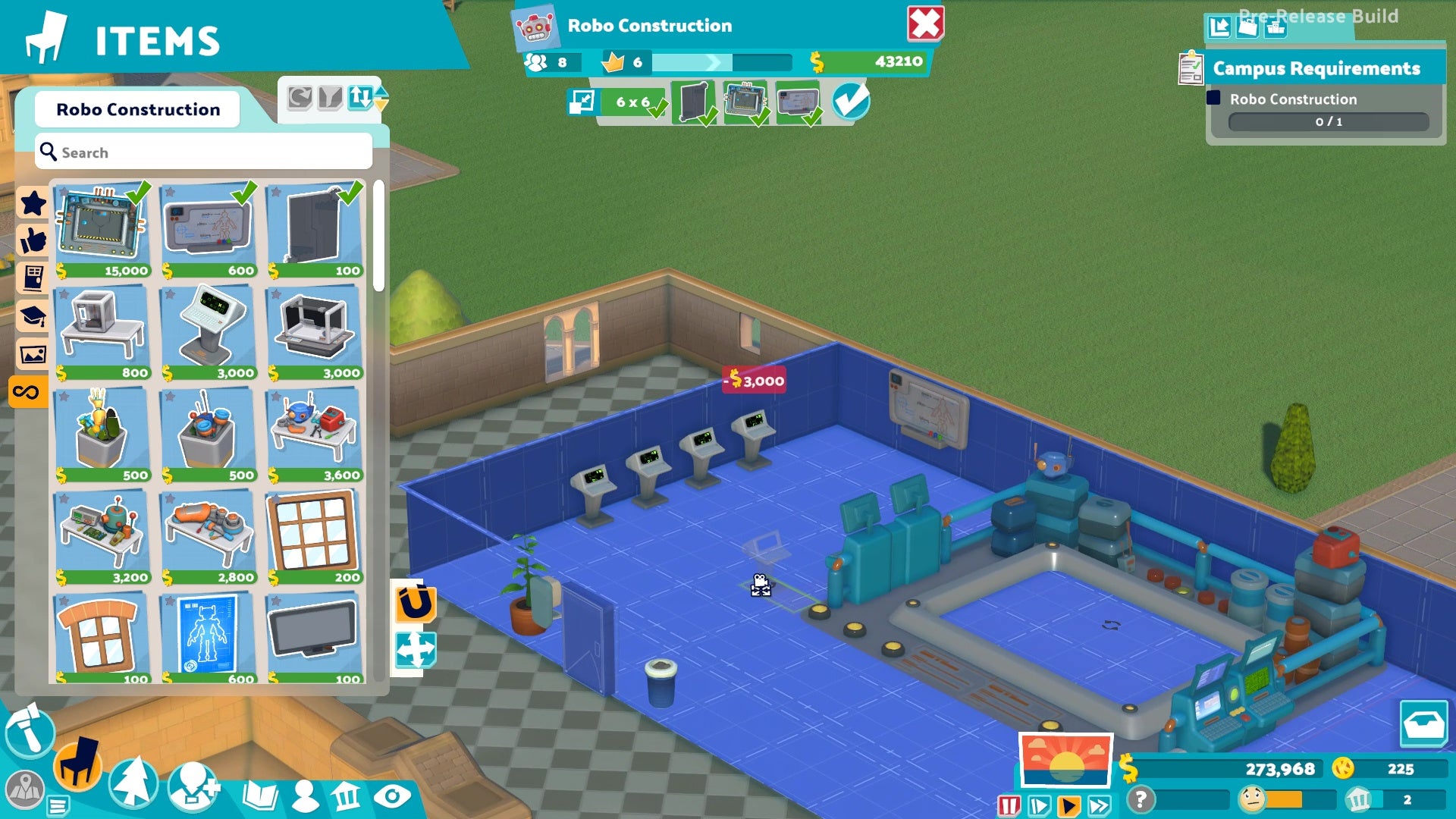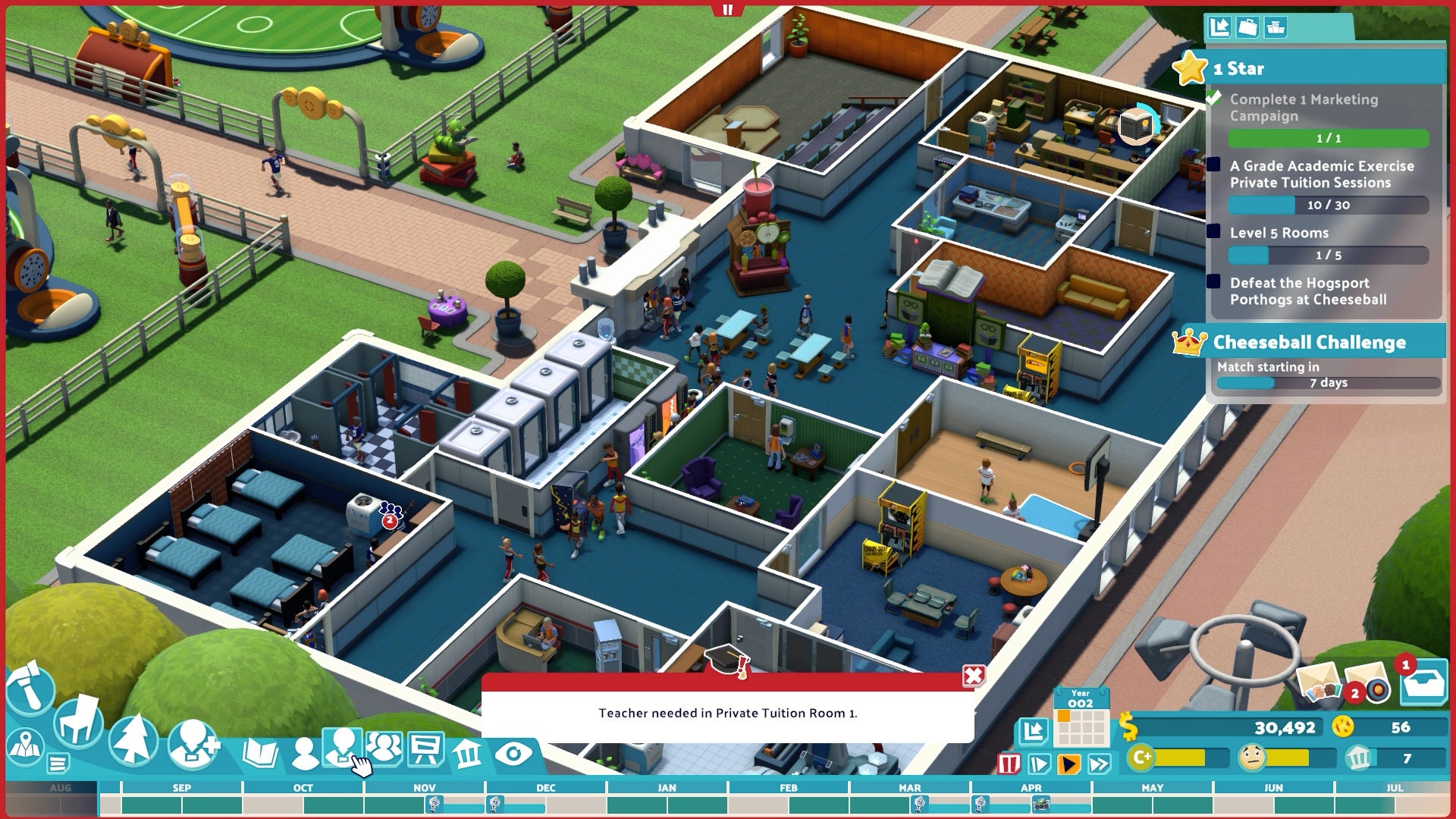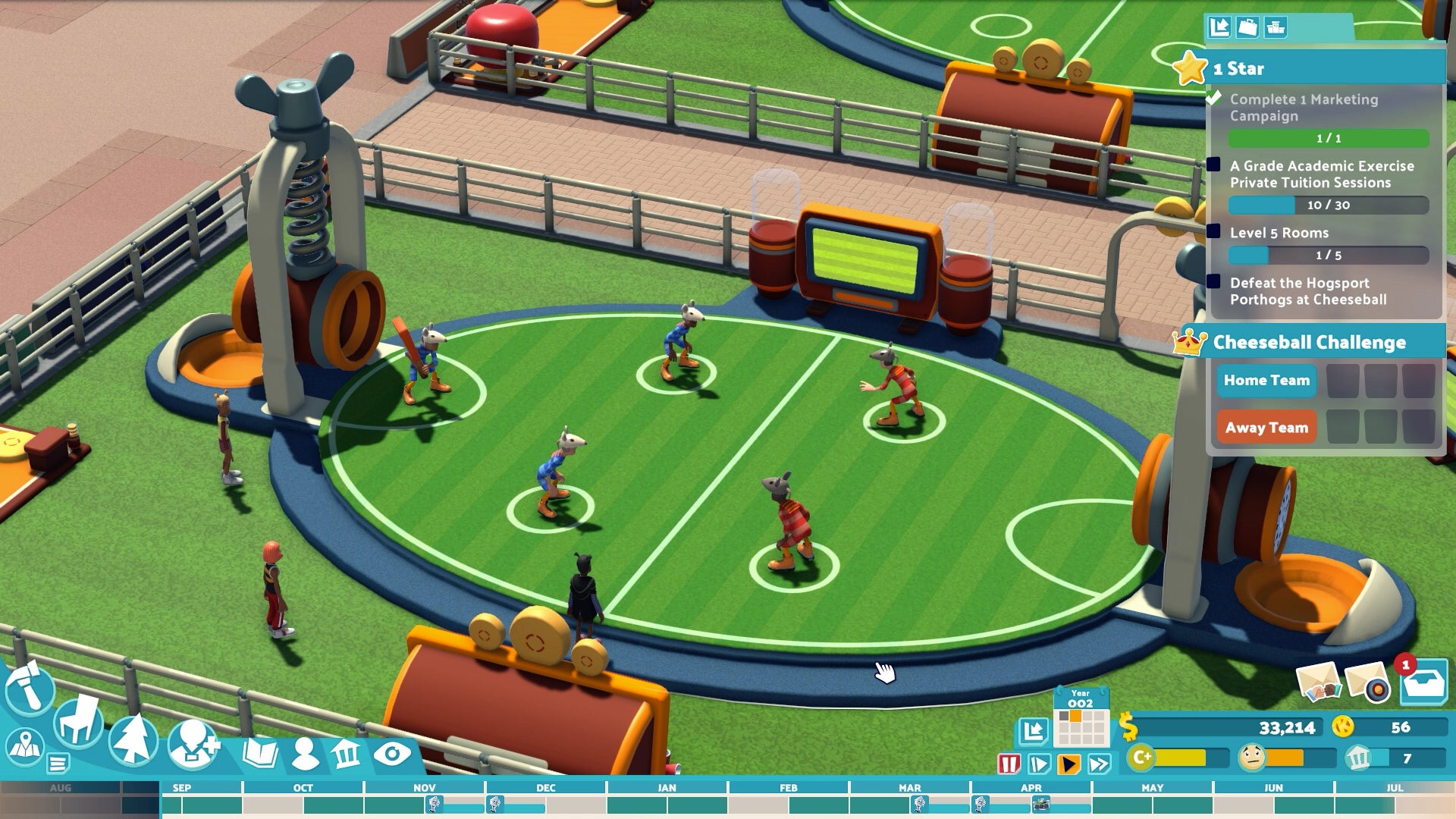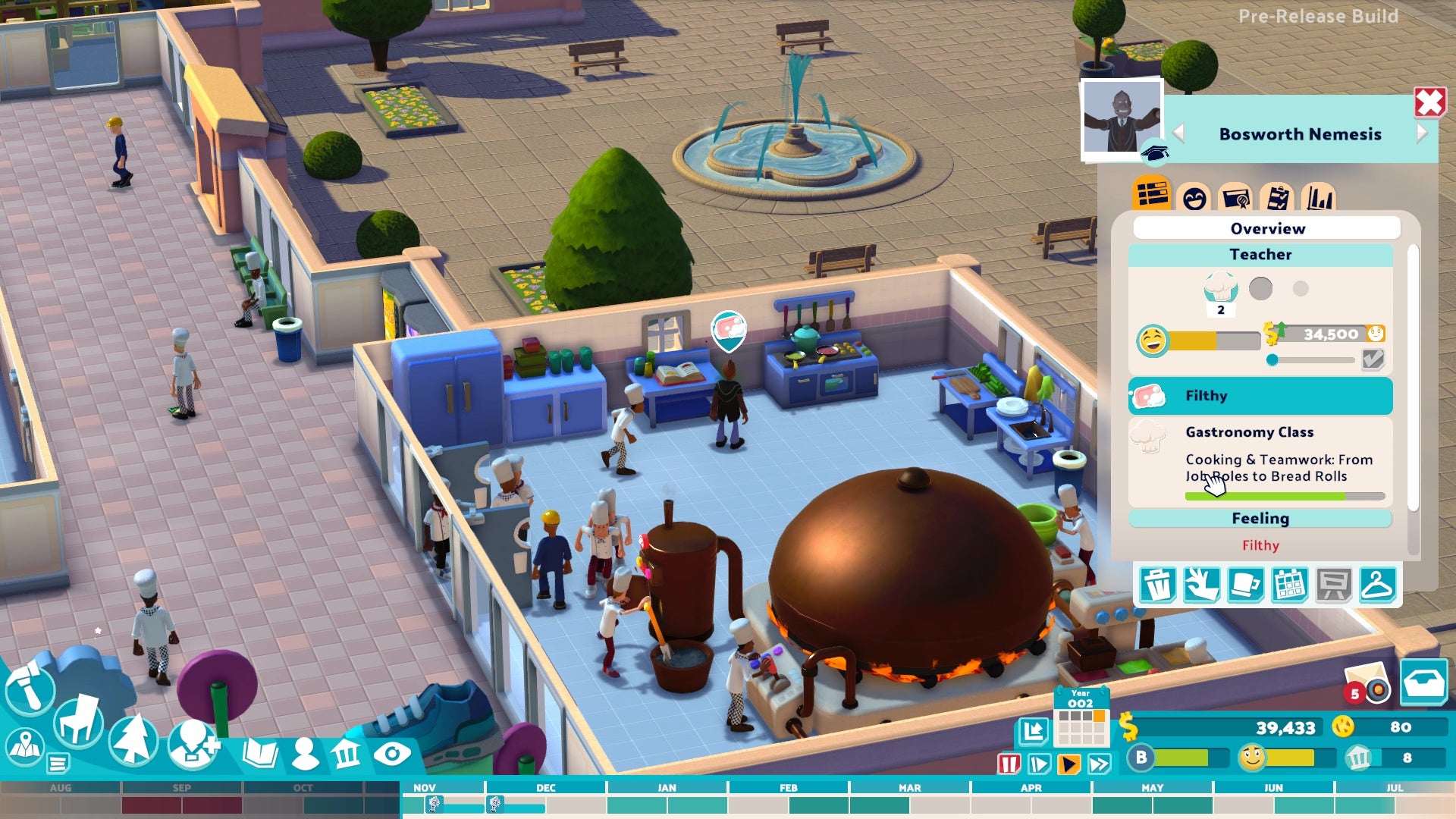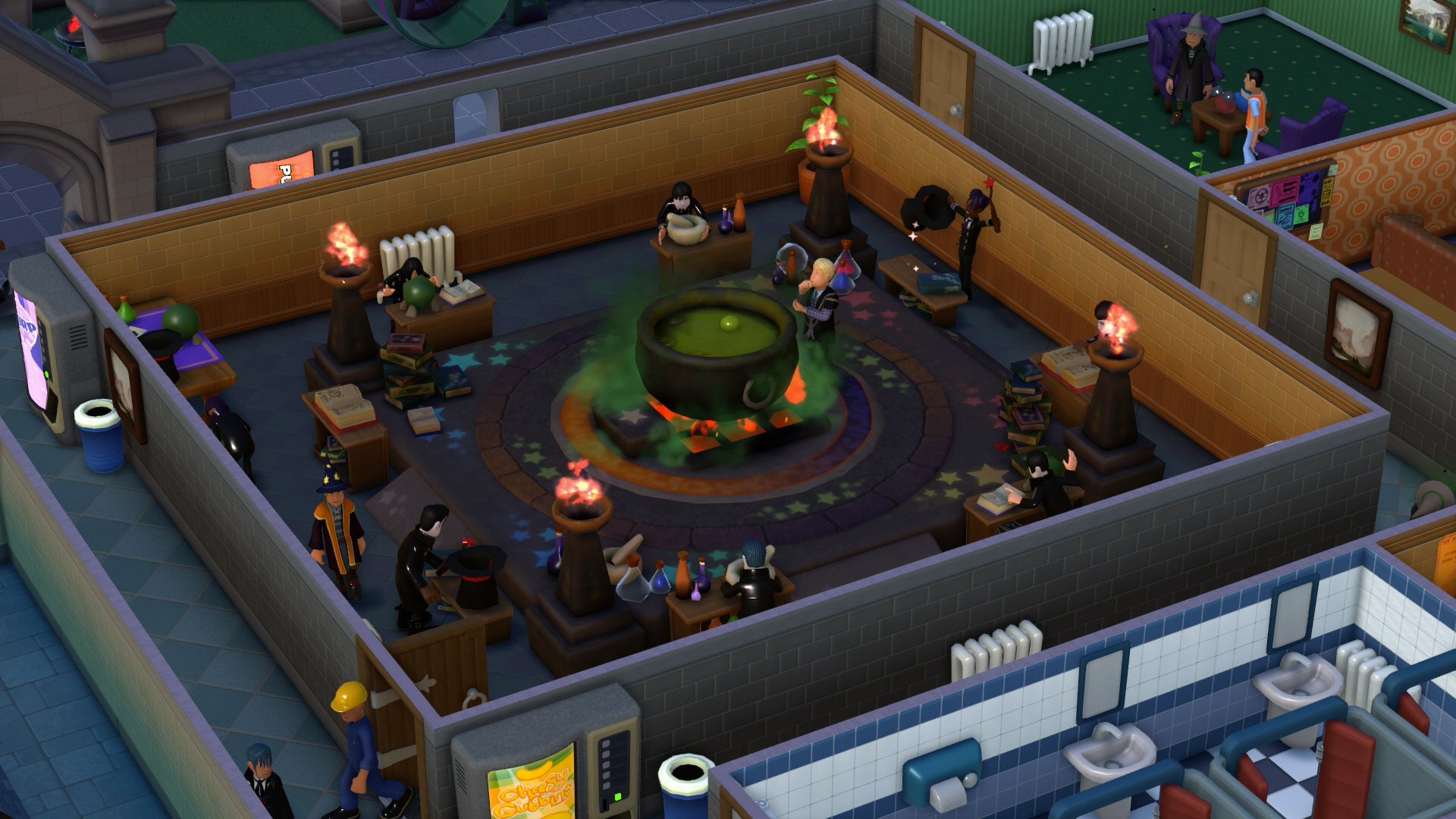The job of a university president is a pretty relaxed affair, which means you’re able to soak in the joys of watching your oddball students grow. But this leniency means it struggles to reward you for constructing a campus that’s uniquely yours. How does the game judge a “solid education”? Through a star rating, naturally, which ranges from one (the student’s union always plays Mr. Brightside as a closer) to three (makes Oxbridge look like a pair of raging bin fires). To hit these ratings, you must tick off objectives that could range from strong hygiene levels, to happy students, to enemy knights that have been successfully reprimanded by your security team and bundled off the grounds. Hit any star rating and you’ll unlock newer, zanier campuses to spruce up. If you want to stick around and elevate your universities to three-star status, you can do that too, as they all exist as ongoing projects you can dip in and out of at any time. For those who aren’t well-versed in management games, Two Point Campus is the perfect springboard into the genre. Often games of this ilk suffer from a lack of direction, with mediocre tips that let you off the leash before you’ve even understood the basics. There’s none of that here, as the game steers you through the basics of building facilities and recruiting staff, highlighting useful bits of the user interface like they’re colourful bookmarks jutting out of a file. This lends the game an immediate sense of gratification, as before you know it, you’re running a campus! More importantly, you understand how it’s running. And the cogs of your academic machine aren’t only designed with simplicity in mind, but also to give you much needed space. Jump into a new campus and you’re the one who decides when the academic year starts, which means that you get all the time in the world to lay the foundations. Each course, whether that’s General Studies or Archaeology, lasts for a total of three years and at the end of each year you’ll get a summer break to invest your profits, tinker with your campus layout, expand the number of courses on offer (or not, depending on your finances), and meet the tougher conditions of returning students. Again, the game provides ample chances to amend with zero pressure. Constructing your campus is a joy, helped along by what I’ll dub “building flow”. To fulfil the requirements of your chosen course – let’s say Robotics – you’ll need to build a Lecture Theatre and a Robotics lab. These acts are as simple as dragging your cursor and snapping together a square or rectangle, before it automatically sticks a door in your hand, then cycles through necessities like a lectern and some seating to get things up and running in a jiffy. You can add extra details like an auto-cue machine or checks notes a poster of a family tree to up its attractiveness rating or boost learning power, both of which will foster happier, more productive students. To hire staff, you bang open a menu and the information is equally clear and crisp: everything’s bundled up in nice icons you hover over for hints and personality traits that offer amusing insights. Those with better traits come with greater salary demands, but financing is rarely an issue. Jenny Enzyme is an excellent librarian who will help students keep upbeat but has an unhinged side that means she’s allergic to using the bin, for instance. Bionicle Johnson is a Robotics teacher who gets jobs done quickly and has a profound urge to piss. They are worth hiring for the names alone. The game does a grand job of adding layers to your building flow. Move between campuses and you’ll take what you learn from one into another, perhaps adding a multitude of courses instead of just one. You’ll learn that students get cold in chilly climates, so you pop radiators down. Students need entertainment, so you pre-emptively craft a suitably miserable student’s union. Before you know it, you’re assigning people to undertake research projects that’ll let you build special items like Dragon Towers for your students undertaking a Knight course, or training existing members of staff, or upgrading your original lecture theatre to be more efficient. And you’re able to tinker with outdoor spaces too, buying plots of land and repurposing them to further your academic empire. You can mess about with trees and paths, stick benches in nice spots, and ramen stands to catch hungry students between private tuition classes. It’s really neat. As the layers fold over one another, there’s the inevitable challenge that comes with keeping them from sliding into chaos. But it’s a challenge that’s largely dictated by how far you want to take the star rating. To reach one star isn’t all too difficult as you can mostly do as you please, but to reach 3? Hoo boy, you’ll need to ensure that you’re hitting all the right notes. But “hitting the right notes” is where the game starts to show some cracks. Less in the sense that it’s revealing something awful or bad, and more in the sense that you view your students as walking ones and zeros. Your students might demand more entertainment, so you build them a thoughtfully constructed lounge with a boombox and arcade machine, tastefully decorated with sofas that match the rugs. But it might not be enough. So, in desperation, you stick eight arcade machines against a wall and bam! Their happiness skyrockets. Despite the game’s emphasis on getting to know your students on a personal level - you know, by clicking on them and monitoring their grades and moods until graduation day three years later – it also lets you get away with, well, not bothering. In fact, I don’t think I know a single name of one of my pupils. If I fulfil their requests and tick off objectives, I know for a fact they’ll be happy. And if not, then I can just dump a bunch of potted plants in a bland space to give them a lift. In being so lenient and chill, the game is guilty of shooting itself in the foot. It’s up to you whether you bother creating a beautiful campus that makes cohesive sense. Where dorms and situated in a separate outhouse, with beds and nice windows. Where corridors are bright and airy. Where the medical centre sits alongside the battlegrounds, so injured Knights can patch up their wounds in a jiffy. To some extent, yes, doing these things may increase your chances of a successful university anyway, but I’ve managed to create one that’s raking in profits and top grades and looks like an establishment I wouldn’t step foot in, even if I was as desperate for a piss as Bionicle Johnson. In worst-case scenarios, you ditch aesthetics and acquiesce to the system, or sometimes you don’t even have the means to fulfil student needs. This is where Kudosh comes in: a special currency that’s used for buying customisation options and, crucially, many items needed by students to keep engaged or pass their classes. Love benches, love trumpets (?), hydrangeas, a bookcase filled with books specifically on cookery (rows and rows of Gino D’ Acampo’s Fantastico!). Their prices can be extortionate, especially in proportion to the amount you earn, which equates to… not a lot. Ultimately, the game’s relaxed nature means that it’s incapable of acknowledging any truly meaningful decisions you make. You can create a campus that’s aesthetically pleasing or release a deep sigh and slap one together that’s more reminiscent of a prison that reeks of Febreze. Either one will satisfy the inspectors. And yet, you simply can’t knock the game too hard for its chilled out nature, as it’s the main reason you’re able to approach the game however you want. You get to decide how challenging it is and the pace at which you’d like to chase those star ratings. And it’s rare to find a game that’s as much of a pleasure to soak in as this one. It has a jolly atmosphere, with fun radio stations and students who look like the spawn of Wallace from Wallace And Gromit. It doesn’t take itself too seriously either, with wacky courses and surprising twists that aren’t just about hitting monetary goals. You’d be wise to enroll, I reckon.
